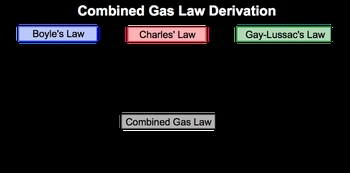The combined gas law is a fundamental principle in chemistry that illustrates the relationship between pressure, volume, and temperature of a gas. It is derived from three key gas laws: Boyle's law, Charles' law, and Gay-Lussac's law. Each of these laws describes how one variable affects another under specific conditions.
Boyle's law states that pressure (P) is inversely proportional to volume (V) when temperature is held constant, which can be expressed mathematically as:
P \propto \frac{1}{V}
Charles' law indicates that volume is directly proportional to temperature (T) when pressure is constant:
V \propto T
Gay-Lussac's law asserts that pressure is directly proportional to temperature when volume is constant:
P \propto T
By combining these relationships, we arrive at the combined gas law, which can be expressed as:
\frac{PV}{T} = k
Here, k represents a constant that remains unchanged for a given amount of gas. This equation allows us to analyze the behavior of a gas when two sets of conditions are known. For example, if we have two sets of pressures, volumes, and temperatures, the law can be rearranged to:
\frac{P_1 V_1}{T_1} = \frac{P_2 V_2}{T_2}
This formulation is particularly useful in solving problems related to gas behavior, enabling predictions about how changes in one variable will affect the others. Understanding the combined gas law is essential for mastering concepts in thermodynamics and physical chemistry.


